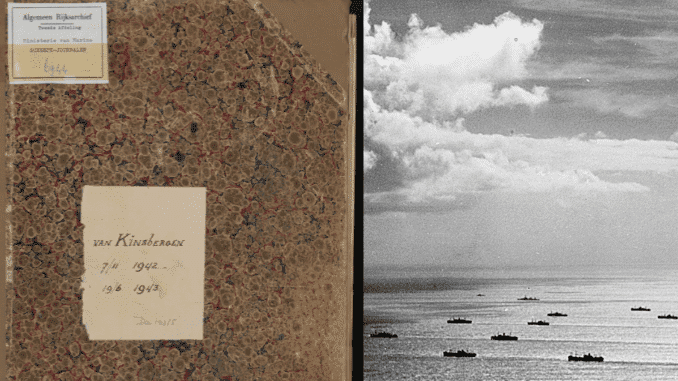
With the United States formally entering WWII because of the attack on Pearl Harbour by Japan, and Germany declaring war in December 1941, Caribbean waters becomes a frontline. The unrestricted submarine warfare waged by Axis forces on Allied shipping takes a tremendous toll in ships sunk and human lives lost.
Through 1942 the convoy system is developed to help move merchant shipping safer through the various Seaboards while providing better Anti-Submarine Warfare (ASW) capabilities. With increased capabilities and resources allocated better protection is achieved reducing losses greatly by early 1943.
At the end of August 1942, the first of the TAG-series convoy sails, the name taken from the intended route Trinidad-Aruba-Guantanamo while convoys travelling in the opposite direction would be named GAT.
Between August 1942 and May 1945 there would be 205 TAG convoys comprising of 3843 individual ship listings. Of these, five TAG convoys would be successfully attacked by U-boats during 1942 and 1943 alone with 12 ships sunk.[1]https://en.wikipedia.org/wiki/TAG_convoys
Sailing on SS El Nil with convoy TAG63
Taking his first tangible step towards joining the war effort Cyril Devaux sails with the ship SS EL NIL on 29 May 1943 from Port of Spain, Trinidad. The ship is part of convoy TAG 63 consisting of around 35 merchant ships, several of them tankers, a much sought after target.[2]http://www.convoyweb.org.uk/tag/index.html
Their escort of four ships are the two Royal Netherlands Navy ships HNLMS Van KINSBERGEN and QUEEN WILLHEMINA as well as the two US Navy ships USS BIDDLE DD-151 (a Wickes-class destroyer) and USS PC-573 (a PC-461-class submarine chaser).
The QUEEN WILHEMINA is actually also a PC-461-class submarine chaser (launched as PC-468) gifted to the Royal Netherlands Navy as a personal gift from President Roosevelt who suggested the ship to be named Queen Wilhemina[3]https://www.netherlandsnavy.nl/PC461.htm.

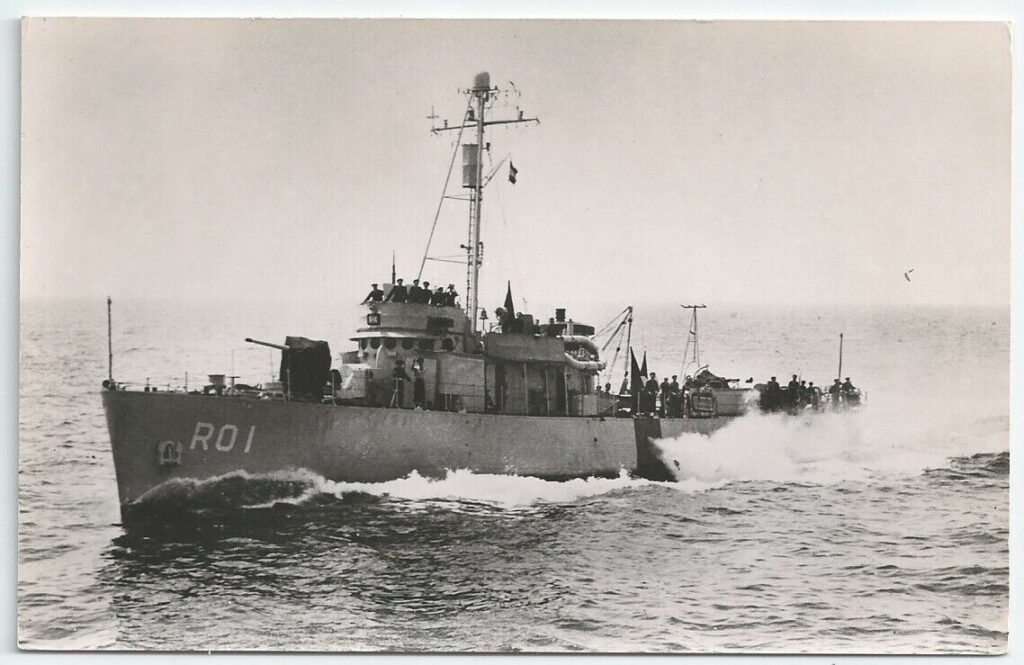
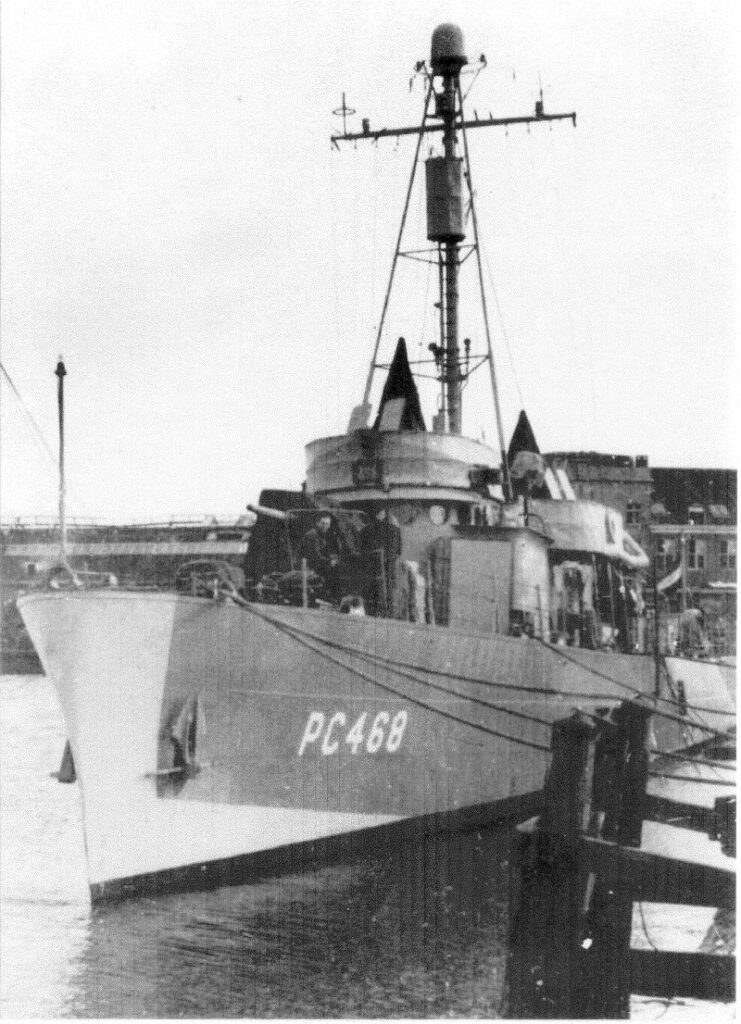
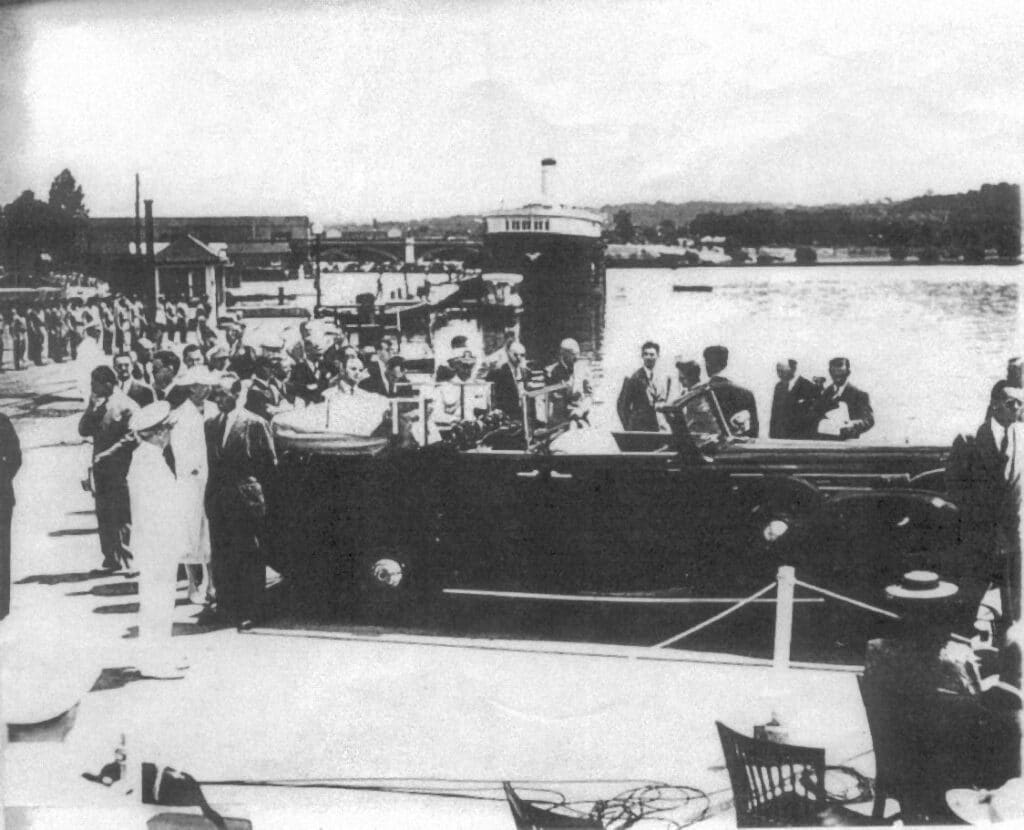
Queen Wilhemina image source.
The Escort Commander is a seasoned veteran Cdr. J.J.L Willinge aboard Van KINSBERGEN. All four escort ships are battle hardened veterans that have seen combat together during numerous escort missions of Caribbean TAG convoys. All four ships participated in the 10 November 1942 events where USS ERIE (PG-50) was lost to U-163 outside Curacao.
On board the convoy flagship, the SS DOROTHY, sails the Convoy Commodore who oversaw the good order of the merchant ships of the convoy. Despite being a civilian title with the peripatetic role of sailing in a suitable merchant ship with each convoy the commodore was usually a retired senior naval officer.[4]https://en.wikipedia.org/wiki/Convoy_commodore
“The Convoy Commodore is the officer, Naval or Merchant. designated to command the convoy. He is responsible for the internal arrangements of the convoy including the assignment of stations to ships in the convoy, for the issue of instructions and regulations for the convoy, and is always responsible for the safe navigation of the convoyed ships. Under normal conditions the Convoy Commodore will control the convoy tactically in accordance with standard instructions for convoys and such additional instructions as he may receive from competent authority.”
United States Fleet Anti-Submarine and Escort of Convoy Instructions” (short title F.T.P. 223A), paragraph 4021.
Although the Escort Commander would invariably be junior to the commodore, the safe and timely arrival of the convoy was ultimately his responsibility.[5]https://www.ibiblio.org/hyperwar/USN/Admin-Hist/011-Convoy/011-Convoy-3.html
The TAG 63 Convoy Commodore was Lt. Cdr John W. Dillinder sailing with a signals staff of 3 men. A US Navy veteran of over twenty years, dating back to service on the submarine tender USS Tallahassee in WWI[6]US, Adjutant General Military Records, 1631-1976, Page 19973 , the Lt Cdr. has held commands on USS Seagull AM-30, a submarine tender, and the Fleet Tug USS Sagamore AT-30.
Departing Port of Spain, Trinidad – 29 May 1943
In the early morning hours of 29 May 1943, the convoy departs and exits the Gulf of Paria through Boca de Navios. At around 7 am the convoy forms up in open waters while the type 128C ASDIC sonar of Van KINSBERGEN is searching for submarine contacts.
The convoy soon leave the Chacachacare Lighthouse behind them, zigzagging and settling on a base course of 300° at about 9 knots. Heading west the Testigos Island is sighted just before 5 pm on a nice day with a light breeze from the NE and a temperature at 27C.
As night falls the convoy prepares for the first night at sea, the BIDDLE has assumed a position astern of the convoy with ship darkened. At 2312 her watch report one of the convoy ships are showing breakdown lights. Although not a death sentence for the broken-down ship it is still a major concern as these waters are by no means safe, and the convoy will not stop to assist.
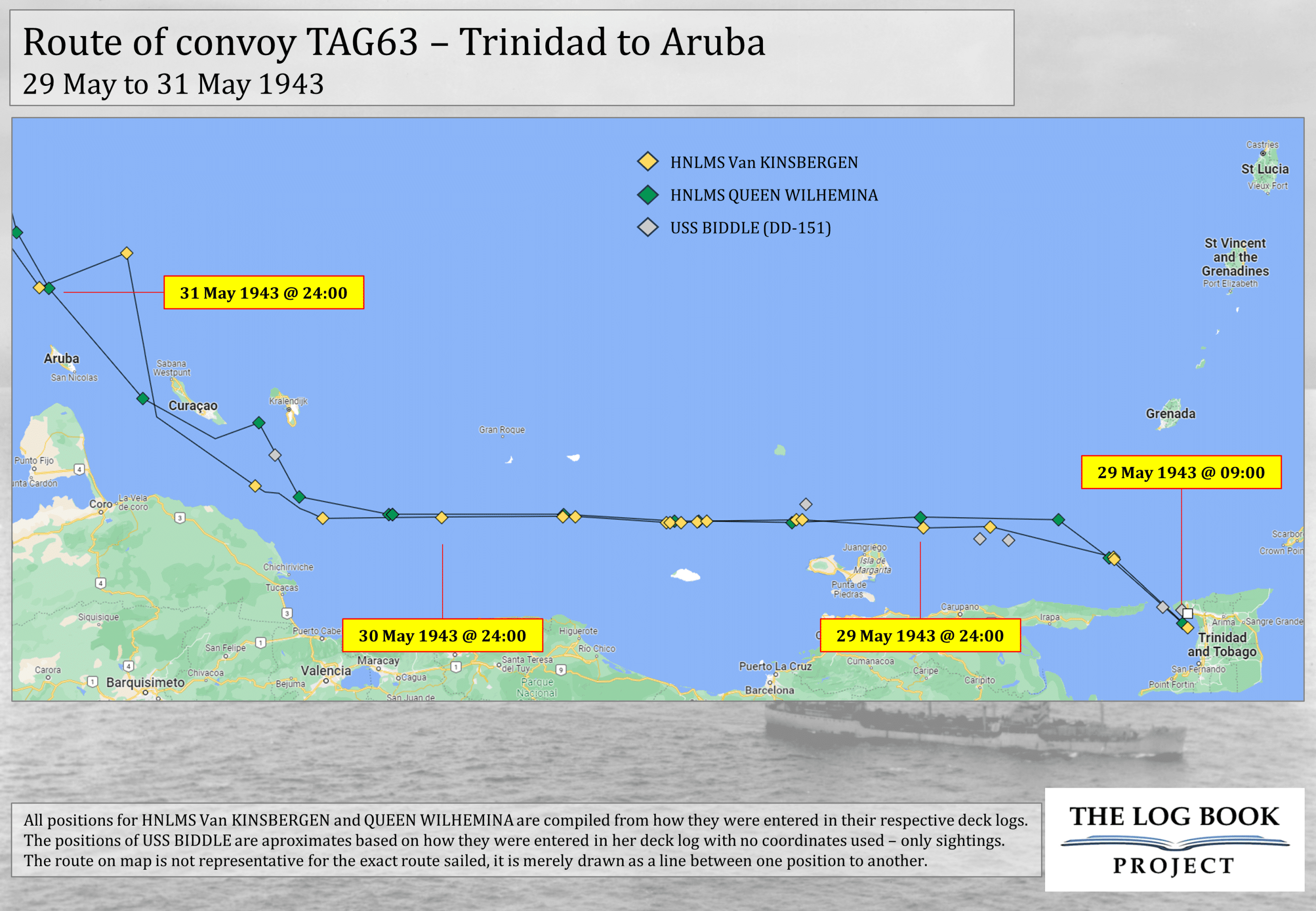
Under way, south Caribbean Sea – 30 May 1943
The next day, by orders of convoy Commander, the BIDDLE leaves station at 1519 to go look for the straggler lost during the night. The ship, identified as the VALLDEMOSA, is luckily soon located astern of the convoy and again under way catching up with the rest of the convoy. Reported as in sight at 1712 by Van KINSBERGEN and fully re-joined by 2100.
The VALLDEMOSA will later in October 1943 suffer a similar breakdown, this time close to Chicken Rock outside Isle of Man in the Irish Sea. With gale force winds and heavy seas, a breakdown in her engine forces her to cast anchor to avoid grounding. With the Port Erin life-boat “Matthew Simpson” standing by the outcome is uncertain through the night. With a tug arriving to assist in the morning the ship is however able to resolve the issues and get away under her on power, tug in attendance.[7]https://rnliarchive.blob.core.windows.net/media/1677/1943wys.pdf – Page 41
On board the EL NIL one can envisage that Cyril Devaux and the nine other BWI’s volunteering for the RAF have settled in. Surely by now it will have sunk in that they are finally on their journey to join the war effort.
Curacao and Aruba – 31 May 1943
Shortly after 10 am the island of Klein Curacao is sighted and by 1035, also the main island of Curacao is in sight. Three ships detach from the convoy with destination Curacao, at 1140 Van KINSBERGEN receive a message from the Convoy Commodore that EL NIL asking for assistance.
On board the ship a passenger has fallen ill, the situation is apparently very serious. The ship doctor on board, Dr. Tewfik Zarka[8]SS EL NIL crew manifest as filed on arrival to New York 11 June, 1943 (NYT715_6711-1001), an Egyptian that has sailed with EL NIL for a long time, deems the situation so grave that the Van KINSBERGEN doctor is requested.
At 1205 the starboard longboat of Van KINSBERGEN is lowered to take their doctor to EL NIL. The joint decision is to evacuate the patient to Willemstad for further treatment. A longboat from Curacao is despatched to take the patient ashore. Van KINSBERGEN is zigzagging behind the convoy in protection of the ships EL NIL and the DANIEL H LOWNSDALE while the patient is moved to the longboat. Before continuing with the patient ashore the longboat despatched from Curacao comes along the port side of Van KINSBERGEN to drop the doctor of.
Who the patient was is unknown, there are no passengers from EL NIL noted as evacuated to Curacao in the immigration information recorded on arrival to New York. In the information for DANIEL H LOWNSDALE however, Ordinary Seaman Clifford H. Peterson, aged 23, is noted as “left at Curacao”[9]DANIEL H LOWNSDALE crew manifest as filed 10 June, 1943 on arrival to New York 10 (NYT715_6711-0743).
Possibly this is the patient, perhaps he was taken to the EL NIL first, as they had a doctor and the LOWNSDALE didn’t, but with the condition worsening he had to ultimately be evacuated at the decision of the Van KINSBERGEN doctor – we may never know conclusively.
With the doctor back on-board Van KINSBERGEN sails through the convoy to assume her position in front of the convoy. Throughout the day the convoy has been given continuous coverage by Douglas B-18 Bolo bombers and Vought OS2N Kingfisher’s from Aruba.
By 1715 the convoy has absorbed 4 additional ships from Aruba and proceeds Northwest to cross the Caribbean Sea.
The perils of the Caribbean Sea
Caribbean waters as a whole were through the early part of 1943 under less pressure with “only” six Axis submarines operating in the area at the end of the first quarter. In comparison; the last quarter of 1942 had a total of eighteen submarines on duty sinking a total of 51 ships while the six on station in the first quarter of 1943 only had 17 ships sunk [10]https://history.army.mil/books/wwii/guard-us/ch16.htm.
Analysing data compiled from KTBs (log books) by Jerry Mason of www.uboatarchive.net it becomes apparent that at the time of Cyril Devaux’s departure from Trinidad with TAG63 there was only one Axis submarine scheduled to be on station in the Caribbean Sea, the U-176. The u-boat was however sunk on 15 May while patrolling the waters north of Cuba having sunk two ships two days earlier.
By early June 1943 no fewer than thirteen u-boats were making their way across the Atlantic with a further three to follow before month end. Through July sixteen u-boats were on station in Caribbean waters sinking six ships in July. However, by this time Allied ASW had overall become much more efficient, of the sixteen u-boats ten would never return to base and still remain on eternal patrol.
It becomes apparent that Devaux got quite lucky departing on his journey in what could be described as a short “lull”, or gap, in the Battle of the Caribbean. In July of 1943, with Devaux safely ashore in Canada, the carnage commences as the Axis u-boats again populate the waters.
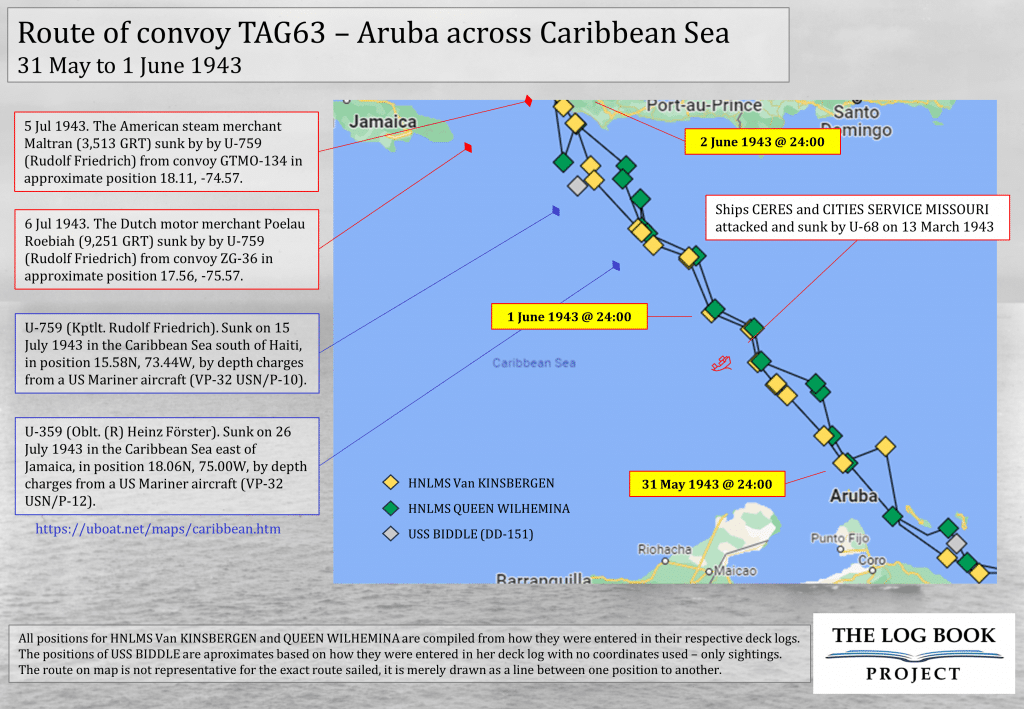
With modern tools, knowledge and access to archives at hand today it is easy to asses and draw conclusions of the level of threat imposed on a certain convoy. One must however never forget or underestimate the fact that at the time, certainly by mid-1943 still, all they knew was carnage.
By perusing reports (War Diary’s) of u-boat sightings and contacts submitted to, and from, various seaboard and section commanders it is clear how tangible the u-boat threat was. The strong conviction of constant u-boat presence in the area remained firm in all reports studied (1943 mostly).
It is against this backdrop that Devaux with 9 other BWI’s sets out on their journey through some of the most contested waters through the conflict.
Under way, Caribbean Sea – 1 and 2 June 1943
Under way on a north-westerly course the convoy pass through the area where ships Cities of Missouri and Ceres were both sunk only a few months earlier. Attacked by U-68 on 13 March 1943 in convoy TAG-49 survivors from both ships were picked up by the BIDDLE that landed them in Curacao the following day.
With the BIDDLE steaming on the port bow of the convoy the day is uneventful except for sighting another convoy.
By 0710 the following morning, 2nd of June, the patrol yacht USS TURQUOISE (PY-18) is sighted and have by 0750 joined the escort force. The TURQUOISE serves as a typical example of some of the vessels commissioned by the US Navy to the Caribbean.
Although formally a US Navy ship she was originally laid down as a private luxury yacht in 1922 and delivered to Eward Willys Scripps, the publisher of the Scripps Howard newspapers. Serving through a succession of owners she is acquired by the US Navy in 1940 in the frantic girder for what ultimately will become WWII.
First classified as a submarine chaser known only as “PC-459” she was later reclassified as a patrol yacht, designated PY-18, and renamed TURQUOISE. Despite her civilian design she can deliver punishment to any submarine with her 3”/50 dual purpose gun and two depth charge racks.

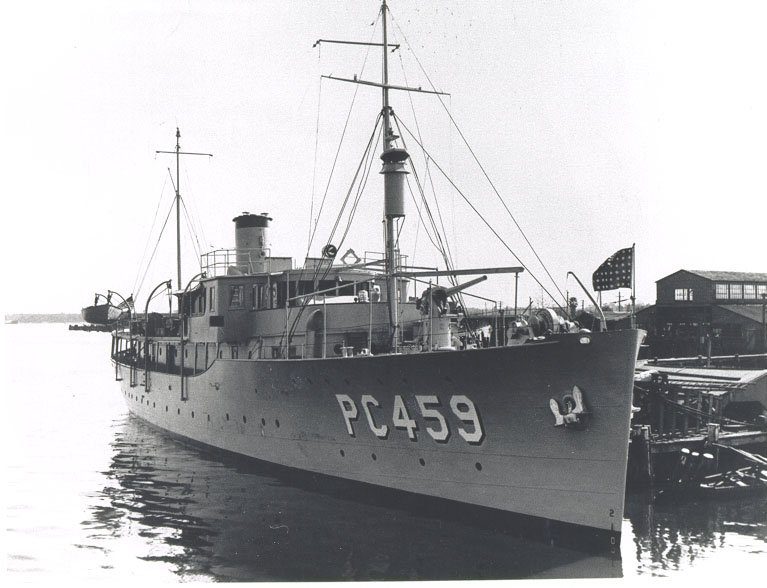
In the afternoon of June 2nd the Van KINSBERGEN receives a message from the Convoy Commodore aboard the DOROTHY that the ship has suffered mechanical issues. The decision is made to swiftly transfer the Convoy Commodore, Lt. Cdr Dillinder, with his staff to another ship.
The ship selected is none other than the EL NIL with our group of BWI’s onboard. The transfer is made utilising one of the PC boats and per the Van KINSBERGEN deck log the Convoy Commodore is back on duty around 2000 on his new convoy flagship. EL NIL will proceed in this capacity through the arrival to Guantanamo, and transition to the northbound GN63 convoy arriving in New York 10 June, 1943.
Guantanamo – 3 June 1943
The convoy TAG-63 sails between Navassa Island and Haiti, proceeding north towards Cuba approaching Guantanamo Bay. Developed to protect the trade routes in the Caribbean the Naval Operating Base Guantanamo Bay (NOB GTMO) was a critical anchor in a chain of naval installations and aviation facilities. Acting as an important intermediate distribution point for merchant shipping it is also a hub where convoys form, dissolve, or transition for further passage.
Here TAG 63 releases several ships from the convoy that is escorted by BIDDLE and TURQUOISE proceeding to port. In these crowded waters outside Guantanamo, that must have been a formidable sight to our group of BWI’s, the convoy transitions from a TAG-63 to GN-63 (Guantanamo – New York) designation.
They have made it so far but still need to navigate through treacherous waters on their next leg to New York. The convoys first challenge is to safely pass through the Windward Passage that has claimed numerous ships falling prey to U-boats. Just two months earlier, on 10 March 1943, two ships were lost to U-185 in the strait between Cuba and Hispanola, the same German submarine scored further success on 6 April 1943 a little further north.
Navigating through the strait, leaving the Caribbean Sea entering Atlantic Ocean, will only move them from one killing field to another. Heading north up the Eastern Seaboard towards New York they will be sailing through waters that less than a year prior was the scene for Operation Drumbeat (Operation Paukenschlag), the Axis relentless attacks on allied merchant shipping along the east coast of North America.
The operation was also commonly known as the “Second Happy Time (Zweite glückliche Zeit)”, among German submarine commanders the period between January and August of 1942 became known as “American Shooting Season”. The EL NIL with Cyril Devaux and his comrades has, all goes well, about 7 days left at sea before reaching New York.
I would like to extend a very special thank you to Martijn van Rooij, this write-up would not have reached its level of detail without his sterling assistance. Painstakingly he translated numerous pages of the Van KINSBERGEN deck log from Dutch to English, in no way an easy task. Just to decipher and interpret the handwritten entries in a naval deck log is hard, to then add translation to the mix… Thanks to van Rooij the translated entries gave a deeper understanding for the journey and a glimpse of how it unfolded.
Lars McKie – september 2023
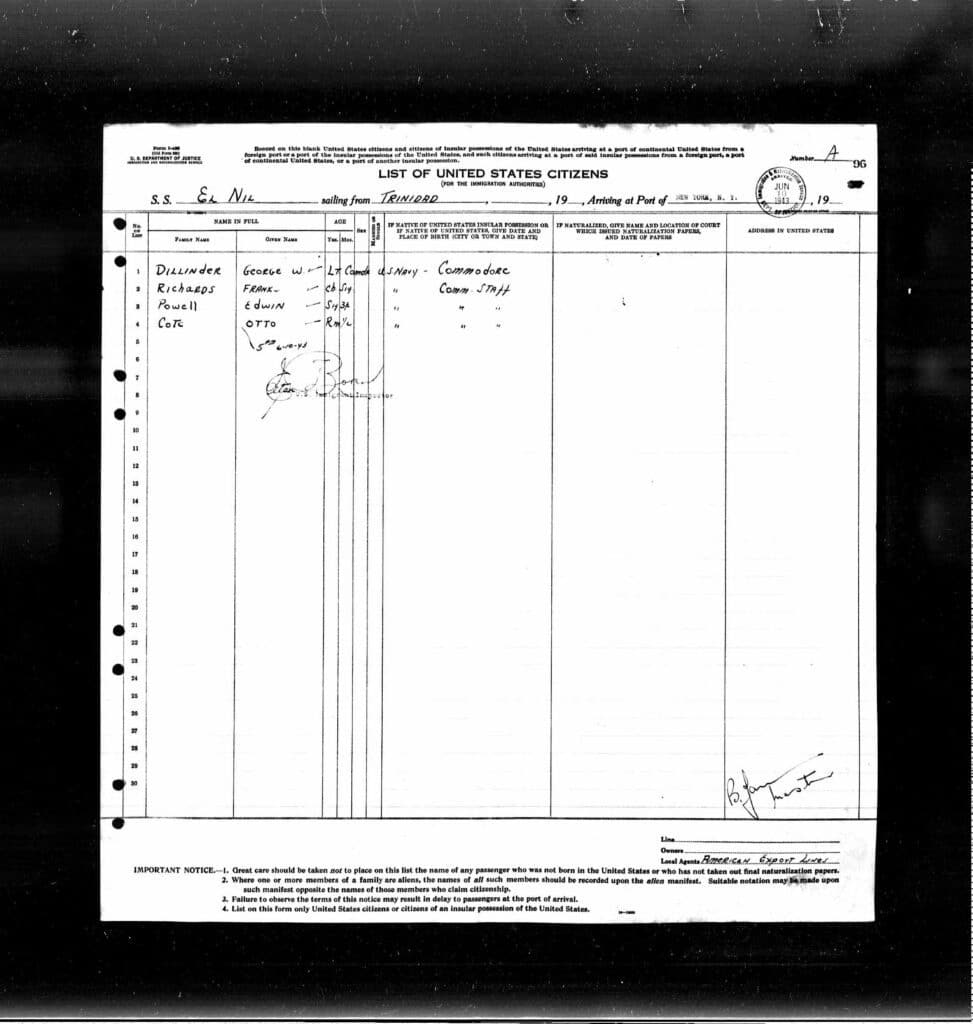
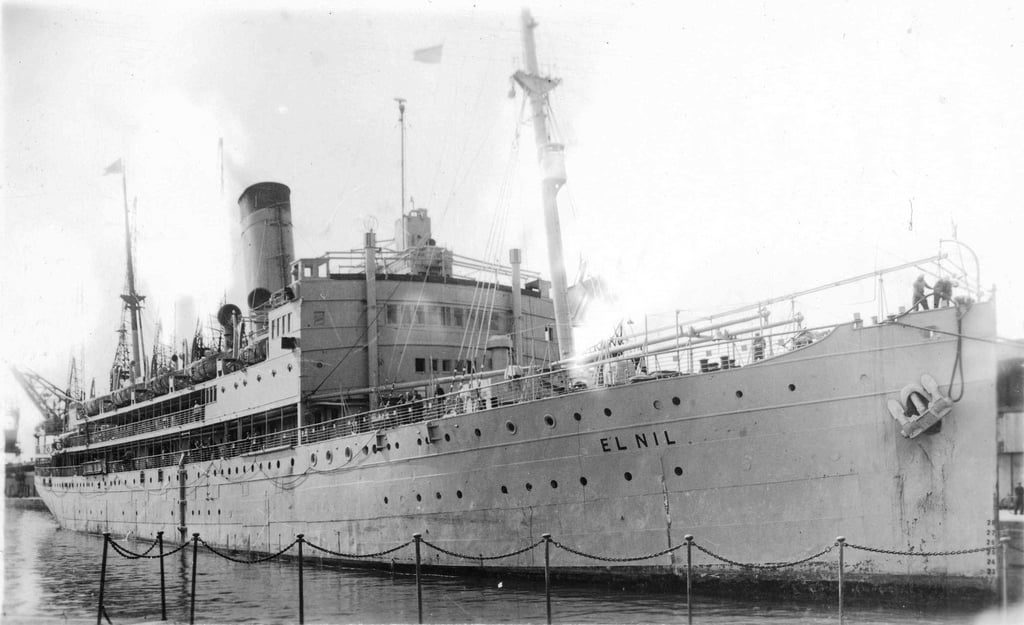
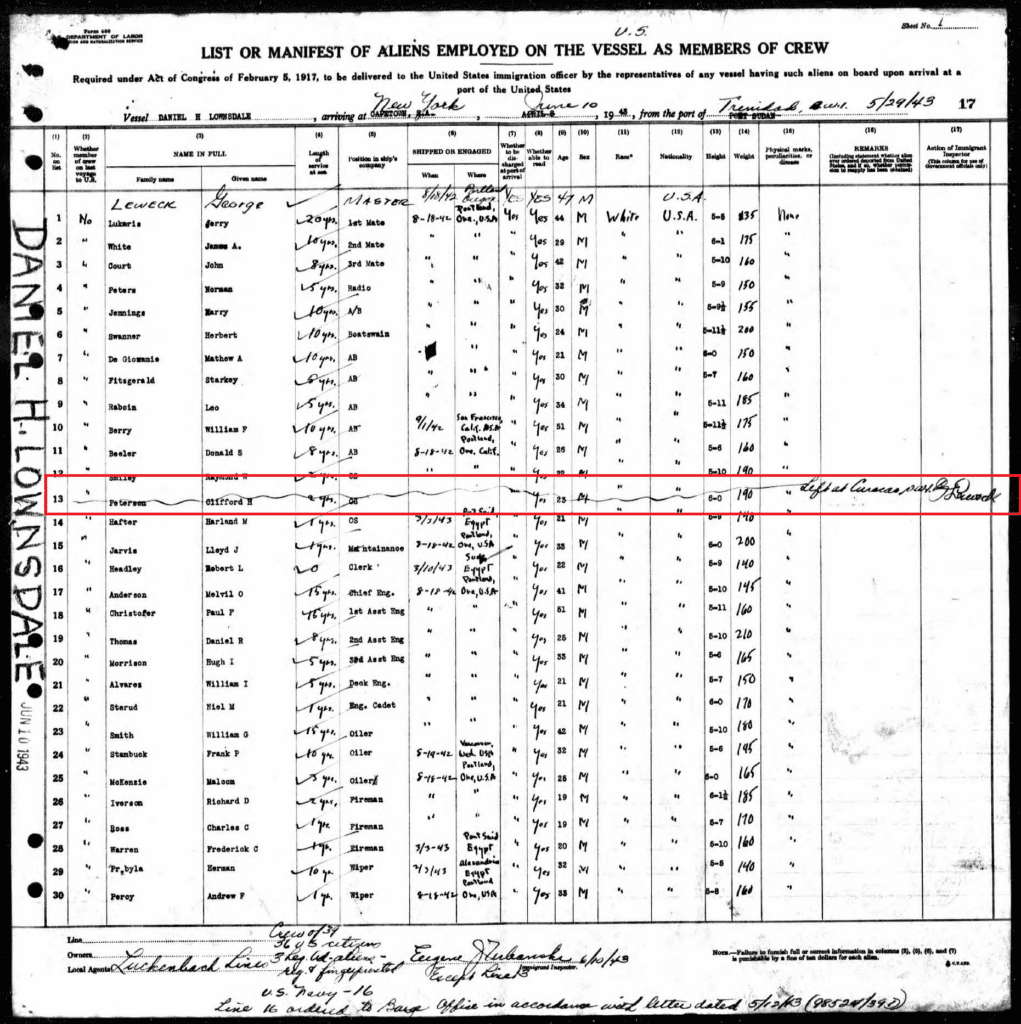
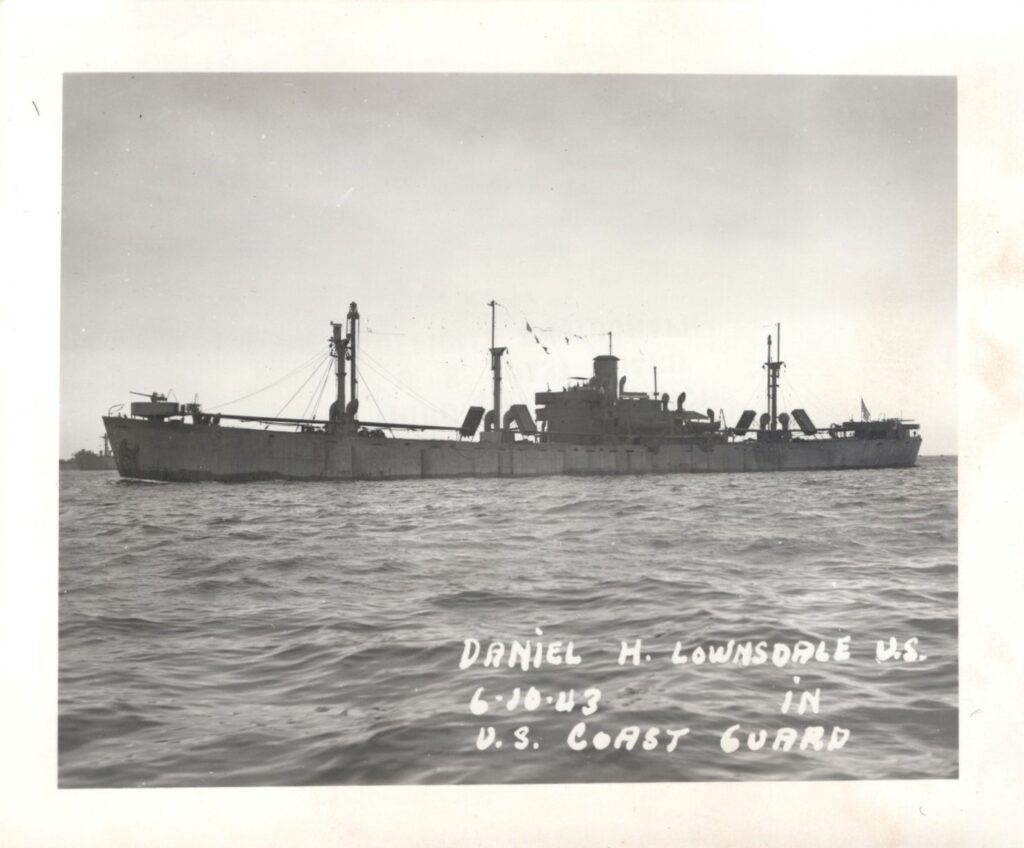
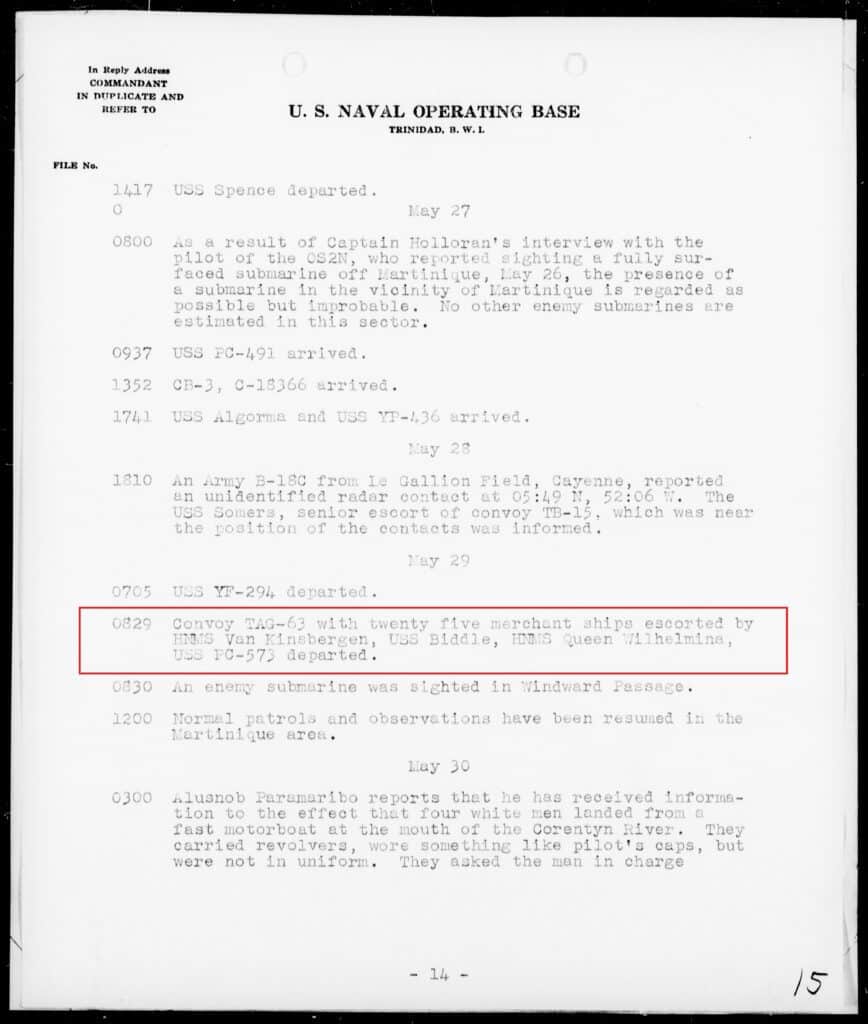
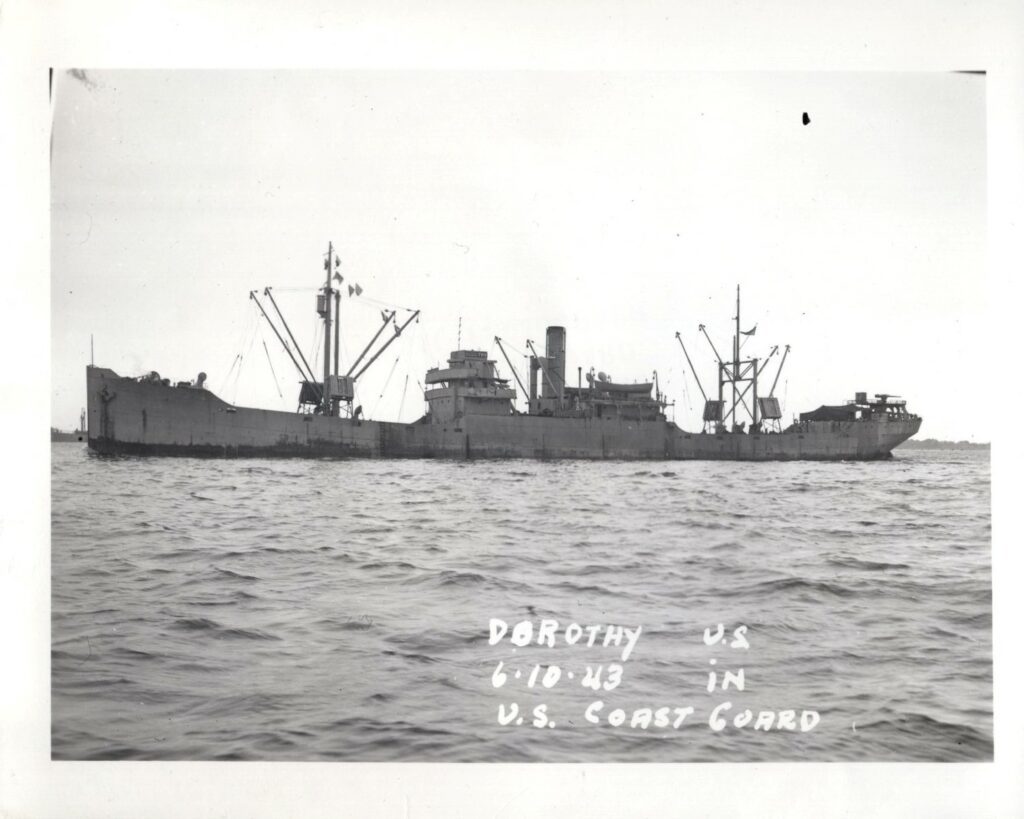
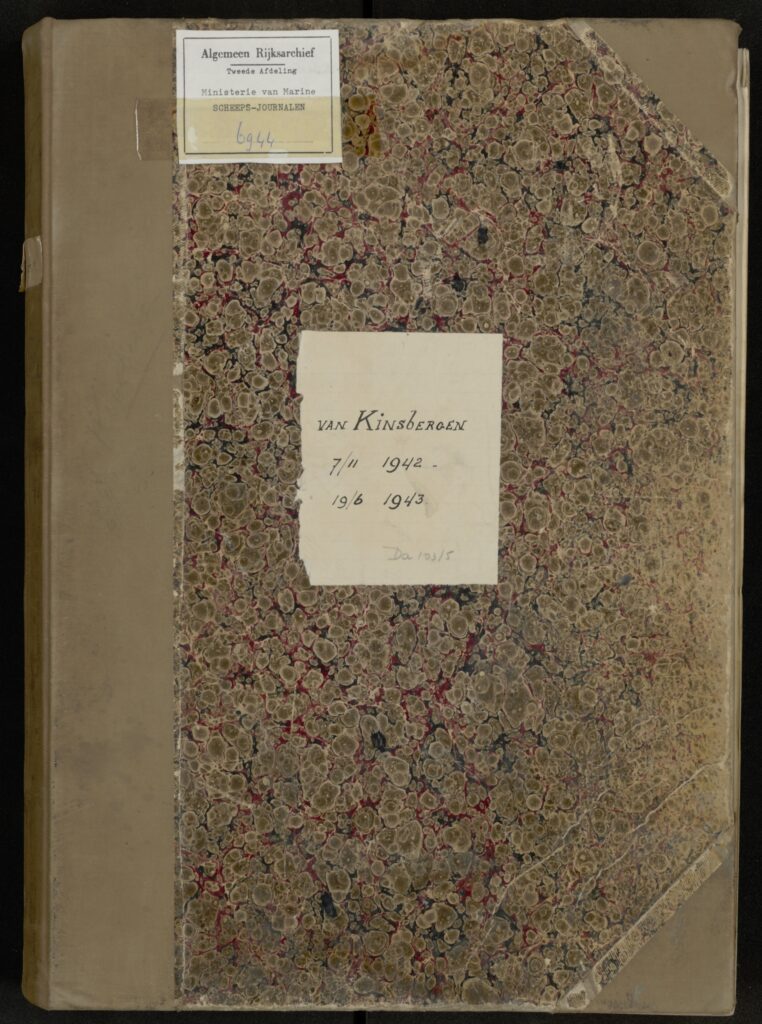
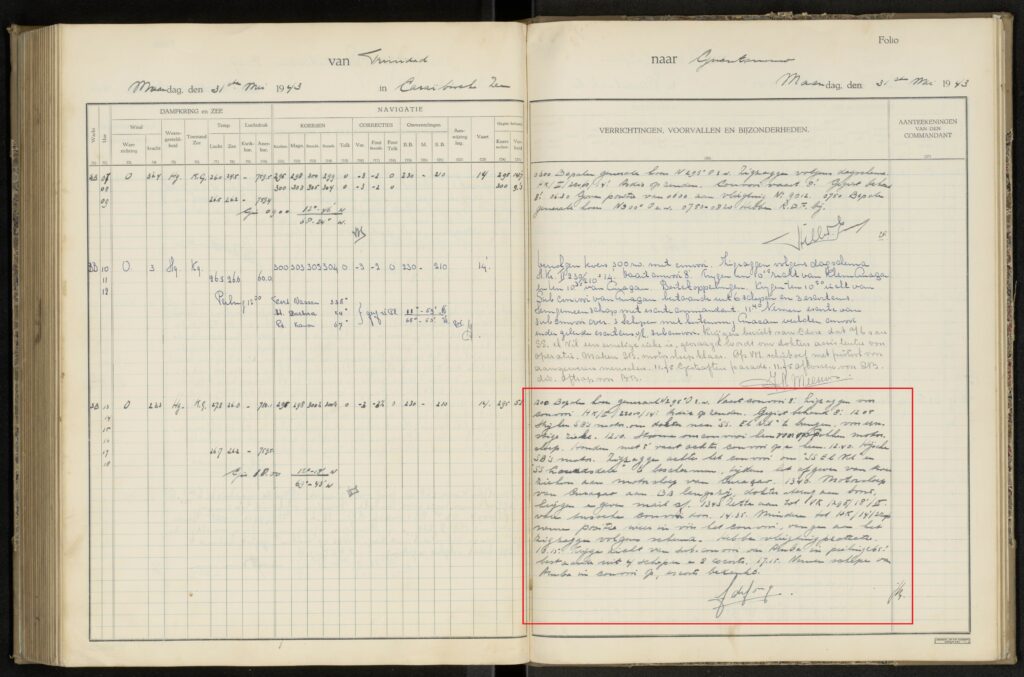
References


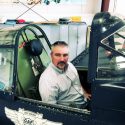
Be the first to comment